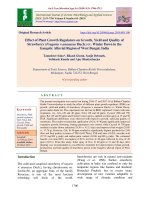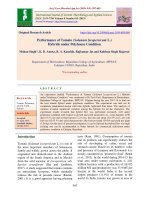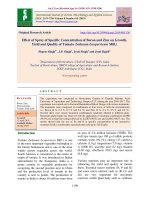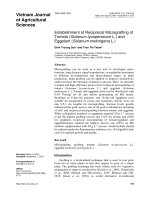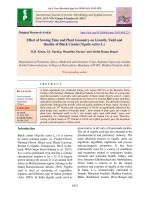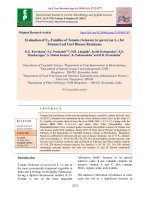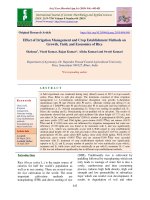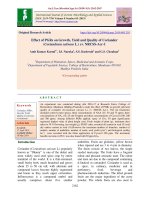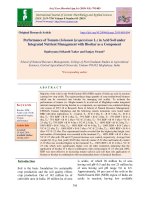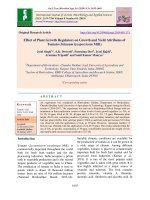Effect of spray of specific concentration of boron and zinc on growth, yield and quality of tomato (Solanum lycopersicum Mill.)
Bạn đang xem bản rút gọn của tài liệu. Xem và tải ngay bản đầy đủ của tài liệu tại đây (213.01 KB, 9 trang )
Int.J.Curr.Microbiol.App.Sci (2019) 8(5): 1198-1206
International Journal of Current Microbiology and Applied Sciences
ISSN: 2319-7706 Volume 8 Number 05 (2019)
Journal homepage:
Original Research Article
/>
Effect of Spray of Specific Concentration of Boron and Zinc on Growth,
Yield and Quality of Tomato (Solanum lycopersicum Mill.)
Sharas Singh1*, J.P. Singh1, Jyoti Singh1 and Jyoti Bajeli2
1
2
Department of Horticulture, CSAUAT Kanpur (UP), India
Section of Horticulture, RMD College of Agriculture and Research Station,
IGKV Ambikapur (CG), India
*Corresponding author
ABSTRACT
Keywords
Boron, Zinc,
Micronutrients,
Tomato, Fruit yield
Article Info
Accepted:
12 April 2019
Available Online:
10 May 2019
The experiment was conducted in Horticulture Garden of Chandra Shekhar Azad
University of Agriculture and Technology, Kanpur (U.P.) during the year 2016-2017. The
experiment was carried out in Factorial Randomized Block Design with sixteen treatments.
The treatments were comprised of combination of four levels of both the micronutrients
i.e., Boron (0 %, 0.2 %, 0.3 % and 0.4 %) and Zinc (0 %, 0.4 %, 0.5 % and 0.6 %).
Overall, there were sixteen treatment combinations randomly allotted to different plots.
Maximum plant height was observed with the application of treatment combination Zn3B0
(98.94 cm) at final harvesting followed by Zn3B3 (98.92 cm) and Zn3B2 (98.87 cm). The
results showed that the use of Zn and B at specific concentration in the interactive
treatment Zn3B3) considerably increased total yield up to 520.22q/ha
Introduction
Tomato (Solanum lycopersicon Mill.) is one
of the most important vegetables belonging to
the family Solanaceae and is one of the most
widely grown vegetable across the world.
South America is considered as the centre of
origin of tomato. It was introduced in Indian
subcontinent by the Europeans. India is a
prime country in vegetable production by
occupying the second position next to China
and the production level of tomato in the
country is next to potato. The production of
tomato in India is about 18 million tones from
an area of 0.8 million hectares (NHB). The
well ripe tomato (per 100 g of edible portion)
contains water (94.1%), energy (23 calories),
calcium (1.0 g), magnesium (7.0 mg), vitamin
A (1000 IU), ascorbic acid (22 mg), thiamin
(0.09 mg), riboflavin (0.03 mg) and niacin
(0.8 mg).
Various nutrients play an important role in
enhancing the yield and quality of tomato
fruits. Essential macro nutrient (N, P and K)
and some micro nutrient such as (B, Cu and
Zn) are very important for enzymatic
reactions within plant body such as synthesis
1198
Int.J.Curr.Microbiol.App.Sci (2019) 8(5): 1198-1206
of RNA and DNA, protein synthesis,
formation of cell wall, occurrence of
flowering and fruiting, constituents of
important growth hormones, while their
deficiency affects growth and quality of
plants. Boron plays a crucial role in
improving the growth, yield and quality of
tomato. At cellular level, it supports the
development of cell wall, occurrence of cell
division, formation of the vascular bundle,
protein synthesis, root system development,
fruit and seed formation, water relations and
transport of sugar. Moreover, it is also
encourages the uptake of calcium by plants.
Zinc is essential for synthesis of
carbohydrates, protein metabolism and sexual
fertilization, synthesis of nucleic acid and
protein. It helps in seed production and
maturation. It also helps in the utilization of
phosphorus and nitrogen in plant. It is also
essential for the synthesis of tryptophan, the
precursor of Indole Acetic Acid (IAA). The
deficiency of zinc causes shortened internodes
due to non-availability of IAA. Considering
the benefits of these micronutrients, an
experiment was conducted with an objective
to use Zn and B as foliar spray for improving
the growth and quality parameters of tomato.
Materials and Methods
The experiment was conducted in the
Horticulture Garden of Chandra Shekhar
Azad University of Agriculture and
Technology Kanpur (U.P.) during the year
2016-2017. Geographically, Kanpur is
situated in the Gangetic plains of central U.P.
It lies in altitude and longitude ranges
between 25.28˚ to 28.50˚ North and 79.31˚ to
84.34˚ East at elevation of 125.90 m above
sea level. Kanpur is characterized by the subtropical climate with hot dry summer and cold
winters. The annual rainfall is about 800-850
mm. The major portion of rain is received
between July and September, with scattered
shower in winter from the North-East
monsoon. The maximum temperature ranges
from 24°C to 46°C and minimum 6.0°C to
24.8 °C with relative humidity from 32 to
99% in different months of the year. The
experiment was laid out in Factorial
Randomized Block Design with three
replications on tomato variety ‘Azad T-6’.
Transplanting of Seedlings was done at a
spacing of 45 x 30 cm and total 25 seedlings
were
accommodated
in
each
plot.
Immediately after transplanting, light
watering with rose can was given to avoid
transplanting shock. A total of 16 treatments
using different concentration of each
micronutrients viz., the treatment comprised
combination of four levels of Boron (0 %, 0.2
%, 0.3 % and 0.4 %) and Zinc (0 %, 0.4 %,
0.5 % and 0.6 %).
Results and Discussion
Morphological characters
Height of plant at final harvesting (cm)
The plant height at final harvesting was
influenced significantly by Zn and B
concentrations.
Effect
of
different
concentrations of Zn and B on plant height
has been presented in Table 2. The plant
height was found maximum with Zn3 (98.76
cm) followed by Zn2 (97.74 cm), while, it
was found minimum with Zn0 (93.96 cm). It
was recorded maximum in B3 (98.56 cm)
followed by B2 and B1 as 98.55 cm and 97.08
cm, respectively. While, minimum plant
height was recorded in the treatment B0
(93.57 cm). B1, B2 and B3 concentrations
were found at par when compared with each
other. The treatment combination Zn3B0
showed maximum plant height (98.94 cm) at
final harvesting followed by Zn3B3 (98.92
cm) and Zn3B2 (98.87 cm). The minimum
plant height (86.30 cm) was recorded in
Zn0B0 followed by Zn0B1 (93.00 cm) and
1199
Int.J.Curr.Microbiol.App.Sci (2019) 8(5): 1198-1206
Zn1B0 (93.37 cm). These results are close
agreement with Babu (2002), Hamsaveni et
al., (2003), Narayan et al., (2007), Patil et al.,
(2010), Haque et al., (2011), Rab and Haq
(2012) and Ali et al., (2013) in tomato and
Hatwar et al., (2003) in chilli.
Number of primary branches per plant
Interactive effect of Zn and B was also found
significant at 90 DAT. Effect of different
concentrations of Zn and B on number of
primary branches per plant at 90 days after
transplanting has been presented in Table 1.
Number of primary branches per plant at 30
days after transplanting was found maximum
8.27 with Zn3B3 treatment combination
followed by Zn3B2 and Zn3B1 showed 8.21
and 8.13 primary branches, respectively. It
was recorded minimum 4.85 in Zn0B0
(control) followed by Zn0B1 (7.32) and
Zn0B2 (7.45) respectively (Table 1). Number
of primary branches per plant at 60 days after
transplanting was found maximum 12.08 with
Zn0B3 followed by Zn0B2 and Zn3B1 i.e.
11.90 and 11.40 respectively. It was recorded
minimum (7.80) in Zn0 B0 (control) followed
by Zn1B0 (9.05) and Zn1B1 (9.52)
respectively (Table 1). It was recorded
maximum (13.39) with Zn2 followed by Zn3
(13.36) and Zn1 (13.04). It was recorded
minimum in Zn0 i.e. 11.72. Zn1, Zn2 and Zn3
were found to be at par in this regard.
It was recorded maximum (13.44) with B3
followed by B2 (13.36) and B1 (13.06). It was
recorded minimum in B0 i.e. 11.92. B1, B2
and B3 when compared with each others
found to be at par. The interaction between Zn
and B was also found to be significant.
Interactive treatment Zn3B3 produced
maximum (13.89) number of primary
branches per plant at 90 days after
transplanting which was followed by Zn3B2
(13.83) and Zn2B3 (13.56). It was recorded
minimum 8.65 in Zn0B0 followed by 12.40
with Zn0B1.
Number of secondary branches per plant
Interactive effect of Zn and B was also found
to significant at 90 DAT. At 30 and 60 stages
analysis of variance were not analyzed. Only
effects of each treatment regarding this object
were observed (Table 1). Number of
secondary branches per plant at 30 days after
transplanting was found maximum (2.38)
with Zn3B3 followed by Zn3B2 and Zn3B1
i.e. 2.31 and 2.22 respectively. It was
recorded minimum (1.26) in Zn0B0 (control)
followed by Zn0B1 (1.52) and Zn0B2 (1.87),
respectively (Table 1). Number of secondary
branches per plant at 60 days after
transplanting was found maximum (8.33)
with Zn3B3 followed by Zn3B2 and Zn3B1
i.e. 8.27 and 8.20, respectively. It was
recorded minimum (5.65) in Zn0B0 (control)
followed by Zn0B1 (7.45) and Zn0B3 (7.62)
respectively. Number of secondary branches
per plant at 90 days after transplanting was
influenced significantly by Zn and B
concentrations. Interaction of Zn and B
concentrations was also found to be nonsignificant.
Boron
also
significantly
influenced the number of secondary branches
per plant at 90 days after transplanting. It was
recorded maximum (9.72) with B3 followed
by B2 (9.67) and B1 (9.45) while minimum
9.11 in B0. B3 did not differ significantly
when compared with B2 and B1. The
interaction between Zn and B was found to be
non-significant.
Interactive treatment Zn3B3 produced
maximum (10.28) number of secondary
branches per plant at 90 days after
transplanting followed by Zn3B2 (10.18) and
Zn3B1 (9.97). It was recorded minimum 8.15
in Zn0B0 followed by 8.98 with Zn0B1.
Similar result was also reported by Patil et al.,
(2008), Agrawal et al., (2008), Ullah et al.,
(2015), Yadav et al., (2001) in tomato and
Hatwar et al., (2003) and Natesh et al., (2005)
in chilli.
1200
Int.J.Curr.Microbiol.App.Sci (2019) 8(5): 1198-1206
Days to first flower initiation
Days to first flower initiation was influenced
significantly by Zn and B concentrations.
Interaction of Zn and B concentrations was
also found to be significant. It is clear from
the data given in Table 2 that the days to first
flower initiation was significantly influenced
by the Zn and B. Number of days taken to
first flower initiation was highest (65.82 days)
with Zn3 followed by Zn2 (65.31 days),
whereas, it was minimum with Zn0 (63.01
days). Zn3 when compared with Zn2 and Zn1
it was found to be non-significant. Boron also
significantly influenced the days to first
flower initiation. It was recorded maximum
(65.31 days) with B3 followed by B2 (65.24
days) and B1 (65.02 days). It was recorded
minimum in B0 i.e. 63.47 days. The
interaction of Zn and B was found to be
significant. Interactive treatment Zn3B3
showed maximum 65.99 days to first flower
initiation followed by Zn3B2 (65.95) and
Zn3B1 (65.80 days). It was recorded
minimum 58.73 days in Zn0B0 followed by
Zn0B1 (64.01 days). It may be due to the
application of zinc and boron, the plant
growth was recorded significant and delayed
the flowering in treated plots while the control
has taken minimum days to flowering.
Workers like Ali et al., (2013) in tomato and
Devi et al., (2013) in chilli reported similar
results.
Yield and quality characters
Fruit yield per plant (g)
The fruit yield per plant was influenced
significantly by Zn and B concentrations.
Interaction of Zn and B concentrations was
found to be non- significant. It is evident from
Table 2 that Zn and B significantly influenced
the fruit yield per plant when compared with
control Zn0. Maximum fruit yield was
recorded in Zn3 (1145.11 g) followed by Zn2
(1118.73 g) and Zn1 (1104.44 g). Minimum
fruit yield was observed in Zn0 (995.59 g).
Fruit yield obtained with Zn3 did not differ
significantly when compared among Zn1 and
Zn2 respectively. Boron also influenced fruit
yield and maximum yield per plant was
recorded with B3 (1124.50 g) followed by B2
(1116.02 g) and B1 (1082.28 g), respectively.
The minimum fruit yield per plant was
recorded with B0 (1041.10 g). B1 was found
significant over B0. Similarly, values of B2
over B1 and B3 over B2 did not differ
significantly, whereas, B2 and B3 recorded
significant variation when compared with
control (B0) with this regard. The interaction
of Zn and B was found to be non-significant.
Interactive treatment Zn3B3 obtained
maximum (1170.50 g) fruit yield per plant
followed by Zn3B2 (1163.80 g) and Zn3B1
(1127.37 g). It was recorded minimum 849.27
g in Zn0B0 followed by Zn0B1 (984.99 g)
respectively. Workers like Reddy and Reddy
(1986), Yadav et al., (2006), Patil et al.,
(2008), Patil et al., (2010), Haque et al.,
(2011), Ali et al., (2013) and Kesani et al.,
(2013) also reported similar yield in tomato
and Hatwar et al., (2003) in chilli.
The fruit yield per hectare (q)
The fruit yield per hectare was influenced
significantly by Zn and B concentrations
whereas, interaction of Zn and B
concentrations was found to be nonsignificant. Effect of different concentrations
of Zn and B on fruit yield per hectare has
been presented in Table 2. It is evident from
Table 2 that Zn and B significantly influenced
the fruit yield per hectare when compared
with their controls. Maximum fruit yield was
recorded in Zn3 (508.95q per hectare)
followed by Zn2 (497.22q) and Zn1
(490.32q). Minimum fruit yield was observed
in Zn0 (441.83q). Zn3 showed significant
variation over Zn2 and Zn1 respectively but
significant variation were recorded in all Zn
treatments when compared with control
(Zn0).
1201
Int.J.Curr.Microbiol.App.Sci (2019) 8(5): 1198-1206
Table.1 Effect of spray of specific concentration of Boran and Zinc on Number of primary and secondary branches per plant at
different stages
Treatments
Zn0
Zn1
Zn2
Zn3
S.E.(Diff)
C.D. at 5%
B0
B1
B2
B3
S.E.(Diff)
C.D. at 5%
Zn1B1
Zn1B2
Zn1B3
Zn2B1
Zn2B2
Zn2B3
Zn3B1
Zn3B2
Zn3B3
S.E.(Diff)
C.D. at 5%
Number of primary branches per Number
of Number of secondary branches Number of
plants at different stages
primary
per plants at
secondary
branches per different stages
branches per
plants
plants
30 DAT
4.85
7.81
7.88
7.98
0.383
0.78
4.85
7.32
7.45
7.58
0.383
0.78
7.89
7.93
7.98
7.97
8.07
8.1
8.13
8.21
8.27
60 DAT
7.8
9.05
10.46
10.71
90 DAT
8.65
12.58
13.11
12.32
7.8
11.4
11.9
12.08
8.65
12.4
12.83
12.98
9.52
9.96
10.4
10.68
10.9
10.98
10.86
10.98
11.04
12.99
13.27
13.32
13.35
13.52
13.56
13.49
13.83
13.89
11.70
13.04
7.88
13.36
0.383
0.78
11.92
13.06
13.36
13.44
0.383
0.78
12.99
13.27
13.32
13.35
13.52
13.56
13.49
13.83
13.89
0.766
1.56
1202
30 DAT
60 DAT
90 DAT
1.89
1.99
2.06
7.78
7.88
8.01
9.16
9.33
9.81
1.52
1.87
1.94
7.45
7.68
7.62
8.98
9.23
9.25
1.97
2.05
2.08
2.11
2.17
2.23
2.22
2.31
2.38
7.85
7.98
8.03
7.97
8.09
8.17
8.2
8.27
8.33
9.28
9.47
9.5
9.59
9.81
9.85
9.97
10.18
10.28
8.90
9.35
9.65
10.06
0.161
0.33
9.11
9.45
9.67
9.72
0.161
0.33
9.28
9.47
9.5
9.59
9.81
9.85
9.97
10.18
10.28
0.766
1.56
Int.J.Curr.Microbiol.App.Sci (2019) 8(5): 1198-1206
Table.2 Effect of spray of specific concentration of Boran and Zinc on Height of plant (cm), days to first flowering initiation, fruit
yield per plant (g), and per hec (q) and TSS (brix)
Treatments Height of plant at
final harvesting (cm)
93.96
Zn0
97.30
Zn1
97.74
Zn2
98.76
Zn3
1.097
S.E.(Diff)
C.D. at 5% 2.240
93.57
B0
97.08
B1
98.55
B2
98.56
B3
1.097
S.E.(Diff)
C.D. at 5% 2.240
98.54
Zn1B1
98.62
Zn1B2
98.65
Zn1B3
98.03
Zn2B1
98.39
Zn2B2
98.43
Zn2B3
98.75
Zn3B1
98.87
Zn3B2
98.92
Zn3B3
2.193
S.E.(Diff)
C.D. at 5% 4.480
Zn0
Days to first
flower initiation
63.01
64.88
65.31
65.82
0.617
1.26
63.47
65.02
65.25
65.31
0.617
1.26
64.89
64.97
65.06
65.30
65.41
65.50
65.80
65.95
65.99
1.234
2.25
1203
Fruit yield
per plant (g)
995.59
1104.44
1118.73
1145.15
27.318
55.81
1041.10
1082.28
1116.02
1124.50
27.318
55.81
1100.39
1112.42
1116.70
1116.39
1123.93
1126.62
1127.37
1163.80
1170.50
54.636
N.S.
Fruit yield per Total soluble
hectare (q)
solid (Brix)
441.83
4.63
490.32
4.96
497.22
5.05
508.95
5.12
10.707
0.104
21.87
0.21
462.72
4.66
480.36
4.93
495.45
5.07
499.78
5.09
10.707
0.104
21.87
0.21
489.06
4.96
492.19
5.03
496.31
5.06
496.17
4.99
499.52
5.13
500.72
5.15
501.05
5.10
517.24
5.19
520.22
5.22
21.414
0.209
N.S.
N.S.
Int.J.Curr.Microbiol.App.Sci (2019) 8(5): 1198-1206
Boron also increased fruit yield and
maximum yield per hectare was recorded with
B3 (499.78 q per hectare) followed by B2
(495.45q) and B1 (480.36q), respectively. The
minimum fruit yield was recorded with B0
(462.72q). Per hectare yield of treatment B3
and B2 recorded significant variation over
control barring B1 treatment. The interaction
of Zn and B was found to be non-significant.
Interactive treatment Zn3B3 obtained
maximum fruit yield per hectare 520.22q
followed by Zn3B2 (517.24q) and Zn3B1
(501.05q). It was minimum 377.45q in Zn0B0
followed by Zn0B1 (435.17q) respectively.
Findings are in with the reports of Babu
(2002), Das and Patro (1989), Singh and
Verma (1991), Bhat and Prasad (2004),
Bokade et al., (2006), Yadav et al., (2006),
Meena (2008), Patil et al., (2008), Mishra et
al., (2012), Sarangthem et al., (2015) in
tomato and Karuppaiah (2005) in brinjal.
Total soluble solid (Brix)
The total soluble solid was influenced
significantly by Zn and B concentrations.
Interaction of Zn and B concentrations was
found to be non- significant. It is clear from
Table 2 that Zn and B concentrations
significantly influenced the total soluble solid
over their controls. Maximum total soluble
solid was recorded in Zn3 (5.12°Brix)
followed by Zn2 (5.05°Brix) and Zn1
(4.96°Brix). The minimum total soluble solid
was observed in Zn0 (4.63°Brix). Zn3 did not
show significant variation when compared
among Zn2 and Zn1, respectively. Whereas,
significant variations were observed in all Zn
treatments i.e. Zn1, Zn2 and Zn3 over control
(Zn0). Boron also increased total soluble solid
and maximum total soluble solid was
recorded with B3 (5.09°Brix) followed by B2
(5.07°Brix) and B1 (4.93°Brix), respectively.
The minimum total soluble solid was
recorded with B0 (4.66°Brix). B3 was noted
non-significant value in this regard over B2
and B1, respectively. Whereas, all boron
treatments such as B1, B2 and B3 had
presented significant variations over control
(B0). The interaction between Zn and B was
found to be non-significant. Interactive
treatment Zn3B3 obtained maximum total
soluble solid 5.22°Brix followed by Zn3B2
(5.19°B) and Zn2B3 (5.15°Brix). It was
recorded minimum in Zn0B0 (3.97°Brix)
followed by Zn0B1 (4.68°Brix). Similar
results were reported by Paithankar et al.,
(2004), Patil et al., (2010), Salam et al.,
(2010), Ejaz et al., (2011), Kumari (2012),
Rab and Haq (2012) and Harris and
Vellupillai (2015) in tomato.
It is concluded that plant height, number of
primary branches per plant, number of
secondary branches per plant, spread of
tomato plant, number of fruits per plant,
diameter of fruit, weight of fruit, fruit yield
per plant, fruit yield per hectare, total soluble
solid, ascorbic acid content were increased
with the application of boron at 0.4%, zinc at
0.6%. On the other hand, days to first flower
initiation was recorded minimum in control.
Titrable acidity of fruits were increased with
the application of zinc and decreased with the
application of boron and maximum acidity
was observed in B0 (control). Interactive
treatment Zn3B3 also maximized every
attributes of tomato except acidity. Interactive
treatment Zn3B0 revealed maximum titrable
acidity. From above scenario of result, B3
(0.4%) and Zn3 (0.6%) produced maximum
significant values of every growth, yield and
quality attributes of tomato. So, it is advised
to research workers and vegetable growers of
Central Uttar Pradesh that for obtaining
optimum yield with better quality, spraying
with 0.4% boron and 0.6% zinc is
recommended.
References
Agrawal, B., Sharma, H.U.G. and Harmukh,
N. (2008). Effect of trickle irrigation
1204
Int.J.Curr.Microbiol.App.Sci (2019) 8(5): 1198-1206
along with micronutrient on growth and
yield of tomato F1 hybrid Avinash-2.
Advances in Plant Sciences, vol. 21 (1):
299-302.
Amarchandra and Verma, B.K. (2003). Effect
of boron and calcium on plant growth
and seed yield of tomato. JNKVV
Research Journal, vol. 37 (2): 13-14.
Awar, R. and Karami, E. (2016). Effect of
macro and micro elements foliar spray
on the quality and quantity of tomato.
International Journal of Agricultural
Policy and Research, vol. 4 (2): 22-28.
Ali, S., Javed, H.U., Rehman, N.U.R., Sabir,
I.A., Naeem, M.S., Siddiqui, M.Z.,
Saeed, D.A. and Nawaz, M.A. (2013).
Foliar application of some macro and
micro nutrients improves tomato
growth,
flowering
and
yield.
International Journal of Biosciences,
vol. 3 (10): 280-287.
Chandra, R., Ram, R.B., Prakash, J., Nath, D.,
Kumar, S. and Kumar, M. (2014).
Effect of foliar application of micronutrients on growth and yield
components of tomato (Lycopersicon
esculentum Mill). Trends in Biosci
Devi, C.P., Singh, D.K. and Jain, S.K. (2013).
Effect
of
foliar
feeding
of
micronutrients on growth and yield of
chilli (Capsicum annuum var. (3)
accuminatum L.) cultivar Pant C-3.
Pantnagar Journal of Research, vol. 11
(1): 105-111.
Ejaz, M., Waqas, R., Butt, M., Rehman, S.U.
and Manan, A. (2011). Role of macronutrients and micro-nutrients in
enhancing the quality of tomato.
International Journal of Agro Veterinary
and Medical Sciences, vol. 5: 401-404.
Harris, K.D. and Vellupillai, M (2015).
Effects of foliar application of boron
and zinc and their combinations on the
quality of tomato (Lycopersicon
esculentum Mill.). European Academic
Research, vol. III, Issue 1 / April 2015.
Gurmani, A.R., Din, J.U., Khan, S.U.,
Andaleep, R., Waseem, K., Khan, A.
and
Hadyatullah.
(2012).
Soil
Application of Zinc Improves Growth
and Yield of Tomato. International
Journal of Agriculture & Biology, vol.
14 (1): 91-96.
Haque, M.E., Paul, A.K. and Sarker, J.R.
(2011). Effect of nitrogen and boron on
the growth and yield of tomato
(Lycopersicon
esculentum
M.).
International Journal of Bio-resource
and Stress management, vol. 2 (3): 277282.
Karuppaiah, P. (2005). Foliar application of
micronutrients on growth, flowering
and yield characters of brinjal cv.
Annamalai. Plant Archives, vol. 5 (2):
605-608.
Kesani, N.S., Swain, S.K., Varma, S.V. and
Raju, B. (2013). Effect of foliar
application of micronutrients on growth
parameters in tomato (Lycopersicon
esculentum mill.). Discourse Journal of
Agriculture and Food Sciences, vol. 1
(10): 146-151.
Kumari, S. (2012). Effect of micronutrients
on quality of fruit and seed in Tomato
(Solanum
lycopersicum
L.).
International Journal of Farm Sciences,
vol. 2 (1): 43-46.
Meena, R.S. (2008). Effect of gibberellic acid
(GA3), naphthalene acetic acid (NAA)
and boron (B) on growth, yield and
quality of tomato grown under semiarid conditions of Dholpur (Rajasthan).
Haryana J. Hortic. Sci., vol. 37: (1&2):
113-115.
Mishra, B.K., Sahoo, C.R. and Bhol, R.
(2012). Effect of foliar application of
different micronutrients on growth,
yield and quality of tomato cv. Utkal
Urbasi. Environment & Ecology, vol.
30 (3B): 856-859.
Natesh,
N.,
Vyakaranahal,
B.S.,
Shekhargouda, M. and Deshpande, V.K.
1205
Int.J.Curr.Microbiol.App.Sci (2019) 8(5): 1198-1206
(2005). Effect of micronutrient and
organics on growth, seed yield and
quality of chilli. Karnataka Journal of
Agricultural Sciences, vol. 18 (2): 334-3
Narayan, S., Ahmed, N., Mufti, S., Narayan,
R. and Chattoo, M.A. (2007). Response
of foliar application of micronutrients
on tomato hybrid Vijeta. Environment
and Ecology, vol. 25 (1): 86-88.37.
Patil, V.K., Yadlod, S.S., Kadam, A.S. and
Narsude, P.B. (2010). Effect of foliar
application of micronutrients on yield
and quality of tomato (Lycopersicon
esculentum Mill.) cv. PHULE RAJA.
The Asian Journal of Horticulture, vol.
4 (2): 458-460.
Paithankar, D.H., Sadawarte, K.T., Mahorkar,
V.K. (2004). Effect of foliar application
of boron and DAP fertilization on
quality of tomato (Lycopersicon
esculentum Mill.). Journal of Soils and
Crops, vol. 14 (1): 46-49.
Rab, A. and Haq, I. (2012). Foliar application
of calcium chloride and borax
influences on growth, yield, and quality
of tomato (Lycopersicon esculentum
Mill.) fruit. Turk. J. Agric., vol. 36:
695-701.
Salam, M.A., Siddique, M.A., Rahim, M.A.,
Rahman, M.A. and Saha, M.G. (2010).
Quality of Tomato (Lycopersicon
esculentum Mill.) as influenced by
boron and zinc under different levels of
NPK fertilizers. Bangladesh J. Agril.
Res., vol. 35 (3): 475-488.
Sarangthem, I., Haribushan, A. and Salam, J.
(2015).
Effect
of
boron
and
vermicompost on yield and quality of
tomato (Lycopersicon esculentum cv.
Pusa Ruby) in acid soils. Indian J.
Agric. Res., vol. 49 (1): 13-23.
How to cite this article:
Sharas Singh, J.P. Singh, Jyoti Singh and Jyoti Bajeli. 2019. Effect of Spray of Specific
Concentration of Boron and Zinc on Growth, Yield and Quality of Tomato (Solanum
lycopersicum Mill.). Int.J.Curr.Microbiol.App.Sci. 8(05): 1198-1206.
doi: />
1206
